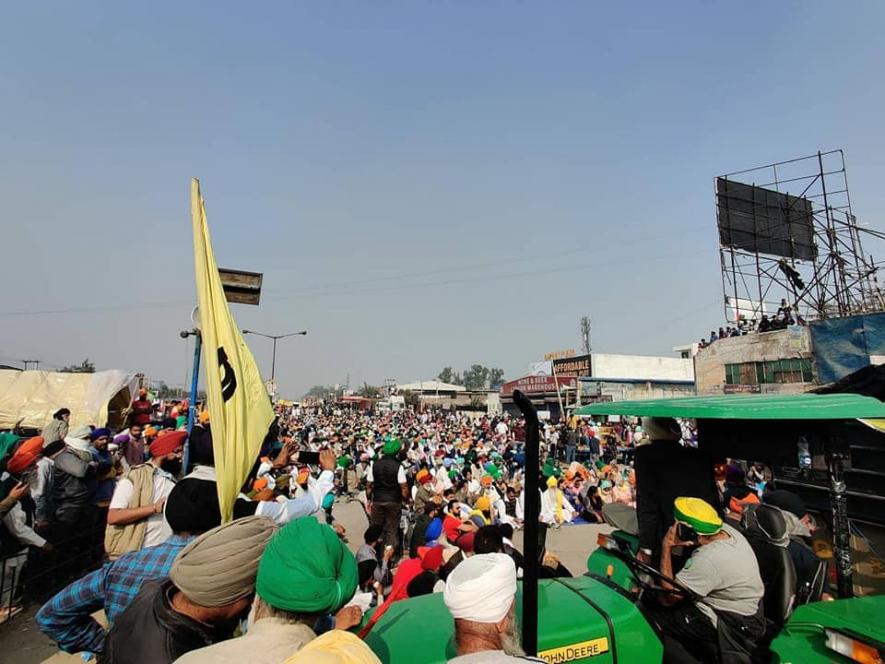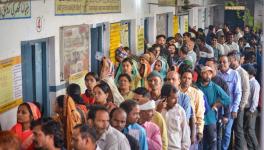Farmers, Sikhs Can’t be Targeted as Muslims were on CAA

From the protest of Muslims against the Citizenship Amendment Act to that of farmers against the three farm laws, the Modi government has shown an inclination to provoke people into protesting and then stamping it out. Its modus operandi has acquired a familiar pattern: pass laws inimical to a segment of the population, dress these as beneficial to India, demonstrate its might to silence those adversely affected. And when they still take to the streets to protest, project them as anti-national who must be suppressed or thrown into prison for the greater good.
This was the script the Modi government invented to break the anti-CAA protests, undoubtedly helped by the lockdown imposed in the wake of the Covid pandemic. This was also the script the Modi government was pursuing to undermine the ongoing farmers’ protest against the three farm laws until it decided to open negotiations with their leaders, even bringing forward the meeting, earlier scheduled for 3 December, to 1 December. A comparative study of the protests against the CAA and the farm laws brings to light the circumstances in which the Modi government’s tactics to isolate protestors fail, although it is still too early to tell whether it would be willing to reform its undemocratic conduct.
The manner in which Modi government enacted the CAA and the farm laws was certainly undemocratic. It did not take into confidence those whom these laws were to have an adverse impact. The controversial laws were presented to them as a fait accompli—accept them or prepare to face a blowback from the state.
In fact, as far as the CAA goes, one of the Bharatiya Janata Party’s purposes to pass the law was to torment the Muslims. Its leaders had been voicing their intent to prepare the National Register of Indian Citizens. They had repeatedly assured the Hindus that they need not fear the NRIC exercise as the CAA would be enacted to safeguard their interests. The CAA was passed in Parliament on 11 December. Apprehensive that they might not have the requisite documents for their inclusion in the NRIC, compounded further by their exclusion from the protective umbrella of CAA, the Muslim youth took to the streets. The police fired stun grenades and tear gas shells and brutally beat up the students of Delhi’s Jamia Millia Islamia. The government was, in effect, conveying to the protestors: “We have the majority. Obey us.”
Pass laws now, explain later
By contrast, the government took advantage of the Covid pandemic to pass the three farm laws, initially promulgated through ordinances. Team Modi thought the farmers will be discouraged from protesting because of the social distancing norm in place. In case they still wished to take the streets, they could be denied permission or forcibly dispersed on the plea of checking the Novel Coronavirus from spreading. A meeting of farmers in Haryana was lathi-charged by the police.
As dissenting voices against the three laws arose in Punjab, which the BJP does not rule, the Modi government insisted its legislative measures would enrich farmers, particularly those who possess marginal or small landholdings. Its narrative was dutifully echoed in the media. The truth, however, is contrary to the government’s claims. Shreya Sinha, in an article based on her research work in Punjab, shows that the agrarian crisis in Punjab cuts across class, caste and gender, the reason why farmers’ unions have been able to forge a broad-based unity among those dependent on agriculture. More pertinently, why explain the benefits of legislative measures after their enactment? Why pass these laws during a truncated parliamentary session, without much debate?
Angry farmers of Punjab took to sitting on railway tracks, bringing the movement of trains through the State to a halt.
Othering dissenters
Rewind to the winter of 2019. After Jamia Millia Islamia students were clobbered, the women of Shaheen Bagh occupied a side of the dual carriageway connecting Delhi to Noida, both of which have an umbilical connection. Their protest demanded that the government should respect their constitutional right to equal citizenship, dramatically conveyed to the nation through a mass reading of the Preamble. Shaheen Bagh was replicated countrywide. These were peaceful protests. In fact, the only States to erupt in violence over the CAA were Uttar Pradesh, Assam and Karnataka, which the BJP rules. In Delhi, the Union government oversees the police.
A new narrative soon emerged. It was argued that the occupation of the road in Shaheen Bagh was inconveniencing commuters and causing traffic snarls in the city. Could not the women shift elsewhere – for instance, to Jantar Mantar, which is designated as the official protest site? Was it legitimate for them to inconvenience those who had no stake in the anti-CAA protests?
In Punjab, the Congress was unwilling to remove the protestors from the rail track. As the State’s stock of coal and petroleum began to deplete, the protestors agreed to allow freight trains to run. No, argued the Indian Railways. “If tracks are clear, they are clear for both freight and passenger trains. We request that the running of trains be left to the railways,” said Railway Board Chairman VK Yadav.
This position of the Modi government was interpreted as a deliberate attempt to inconvenience people and turn them against the protestors, a ploy borrowed from its Delhi play-book. Arterial roads around Shaheen Bagh were needlessly blocked to create traffic snarls, which were then blamed on the anti-CAA protestors. Former chairperson of the National Commission for Minorities Wajahat Habibullah, in his affidavit to the Supreme Court, said as much: “There are numerous number of road that have no connection with the protest that have been barricaded by the police unnecessarily, abdicating their responsibilities and duties and wrongly laying the blame on the protest.”
Towards the end of December 2019, Prime Minister Narendra Modi declared, in a speech in Ramlila Ground, that the CAA would not take away the citizenship from Muslims. Obviously, he did not explain Amit Shah’s past claims that the CAA-NRIC had been designed to throw out the infiltrators, a codeword for Muslims, from India. Nor did the government make an earnest effort to reach out to the protesting Muslims. As Delhi geared up for the Assembly elections, the inconveniencing of Delhiites by Shaheen Bagh protestors was turned into a metaphor of Muslim intransigence. Their leaders, including Shah, demonised Muslims. And though the BJP failed to win the Assembly elections, the theme of inconvenience was turned into a justification for the communal rioting in North-east Delhi in February.
Demonising Sikhs
Many of these elements are present in the Modi government’s strategy to stonewall the protests of farmers. As they wended their way from Punjab, on tractors and trucks and buses, to Delhi, barricades were erected and roads dug up to prevent them from reaching Delhi. They were sprayed with water cannons, even beaten at places. Nevertheless, the protestors broke through. Their aim was to reach Ramlila Ground or Jantar Mantar, to communicate to the Capital’s residents their worries over the farm laws. No, go to Burari, said the administration. The farmers interpreted the administration’s order as an attempt to invisibilise their protest, precisely the point the protestors at Shaheen Bagh would cite to those who counselled them to shift from the Delhi-Noida link road.
As the farmers journeyed and reached Delhi, BJP leaders, including Haryana Chief Minister Manohar Lal Khattar, took to demonising them as Khalistani supporters and Naxalites. Fake photos and videos were floated to show protestors chanting pro-Khalistan, pro-Pakistan and anti-Modi slogans. OpIndia, a right-wing portal, carried a piece under the headline, “Will not say Jai Hind, will teach lesson to Modi like we taught Indira.” Their endeavour was to portray the protestors as anti-national in the hope of stoking the national sentiment against them.
Yet, at this point, the BJP decided to open negotiations with the farmers, without laying down any conditions. It is not hard to imagine why. Realising that the farmers joining those camped outside Delhi were not only Sikh, but also Hindu, the BJP presumably recognised the implausibility of convincing the nation that the protestors are anti-national or dancing to the Opposition’s tune. This is more so as the farmers’ protest has had an echo in pockets of north India’s agricultural belt, which the BJP had swept in the 2019 national election.
Limits of Hindutva
It can be said that the BJP’s weapon of Hindutva failed to split social groups tied by economic interests. Indeed, for once over the last six years, the politics of interest seems to have subordinated the politics of identity. Instead of exposing the limitation of Hindutva, the Modi government thought it prudent to open negotiations with the farmers.
It is also not easy to demonise Sikhs, despite Punjab being rocked by a militant secessionist for a decade. Hindutva has not imagined the Hindu-Sikh relationship as one of conflict, as it has the Hindu-Muslim relationship. It has often portrayed the Sikhs as the fighting arm of the Hindus; its definition of who is Indian includes Sikhs, as India is both their holy land and fatherland. A muscular approach to the problems of Punjab’s peasantry could turn the State restive and pose a national security problem. Punjab is at the border with Pakistan. Through Punjab also passes the most accessible route to Kashmir, which remains alienated from India. A restless Punjab and a disaffected Kashmir could just be too hot a problem for any regime to handle, especially with China looming over Ladakh. A troubled Punjab could also turn its social relations fraught, with Hindus constituting 38 percent of the State’s population.
Yet, at the same time, it seems inconceivable that the Modi government will withdraw the three farms laws, as it prefers to persist with a mistake than rectify it. As of now, it is hard to tell whether the Modi government’s decision to open negotiations with the farmers is merely a PR exercise, designed to persuade the non-farming public that it is willing to listen to dissenters, or a genuine attempt to redress the fears and grievances of the farmers. It can only be hoped that it is the latter, for the BJP will have by now understood that suppressing the protest of Sikhs and farmers is nowhere as simple as it was to stamp out the disquiet of Muslims on the CAA.
The author is an independent journalist. The views are personal.
Get the latest reports & analysis with people's perspective on Protests, movements & deep analytical videos, discussions of the current affairs in your Telegram app. Subscribe to NewsClick's Telegram channel & get Real-Time updates on stories, as they get published on our website.
























